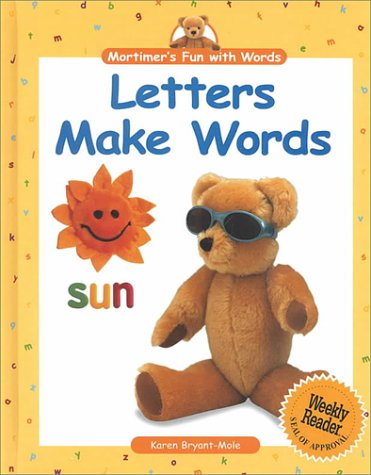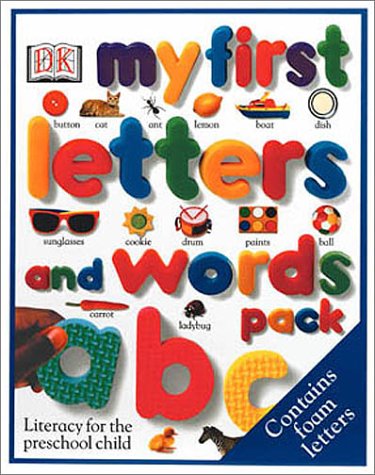-
3 Letter Words
Flash Kids Editors
Cards (Flash Kids, Oct. 5, 2010)Flash Kids Flash Cards offer essential practice in key concepts such multiplication, division, the alphabet, sights words, and state capitals. Containing 88 cards in each package, these cards are sturdier than others on the market. D
D
-
Letters and Words Sudoku
Brian G Tordoff
Paperback (Pageturner, Press and Media, July 6, 2018)This new puzzle is like Sudoku that is used in many new books. But this one is different. It uses letters instead of numbers. It uses nine letters instead of nine numbers and the letters are not always the same. Each puzzle has a list of the nine letters that are being used in each puzzle. Just like the Sudoku puzzles there are nine groups of nine letters. There will be 2 parts for these puzzles. The first part is like the Sudoku puzzles. There will be a 9X9 table with some of the letters missing. This is just like the Sudoku puzzles, only it uses letters. This puzzle is still the same but it may use f t h b m g o e a, or, s m l g b y i o u. Generally, 6 consonants and 3 vowels are used, but there may be times when 7 consonants and 2 vowels, or 5 and 4 are being used. There is also a blank table which is 4 columns by 9 rows. That is the area in which you will record the second part. You have already figured out what all the letters are; now you get to see how many words you can find. This is Part 2. Part 2 is completely different from the Sudoku. This is where you go through your answers to part one and see how many words you can find. Some of the puzzles have as many at 15 words and some as many as 25 words. It is all dependent on the letters that are used. This is the part than can really be difficult. You will be going through the puzzle, after you have done the hard work of finding all the letters, and trying to find words. All words in the answers are at least 3 letters long.
-
Letters and Words Sudoku
Brian G. Tordoff
eBook (Xlibris US, Aug. 25, 2014)This new puzzle is like Sudoku that is used in many new books. But this one is different. It uses letters instead of numbers.It uses nine letters instead of nine numbers and the letters are not always the same. Each puzzle has a list of the nine letters that are being used in each puzzle. Just like the Sudoku puzzles there are nine groups of nine letters.There will be 2 parts for these puzzles.The first part is like the Sudoku puzzles. There will be a 9X9 table with some of the letters missing. This is just like the Sudoku puzzles, only it uses letters. This puzzle is still the same but it may use f t h b m g o e a, or, s m l g b y i o u. Generally, 6 consonants and 3 vowels are used, but there may be times when 7 consonants and 2 vowels, or 5 and 4 are being used.There is also a blank table which is 4 columns by 9 rows. That is the area in which you will record the second part. You have already figured out what all the letters are; now you get to see how many words you can find. This is Part 2.Part 2 is completely different from the Sudoku. This is where you go through your answers to part one and see how many words you can find. Some of the puzzles have as many at 15 words and some as many as 25 words. It is all dependent on the letters that are used. This is the part than can really be difficult. You will be going through the puzzle, after you have done the hard work of finding all the letters, and trying to find words. All words in the answers are at least 3 letters long.
-
Letters and Words Sudoku
Brian Tordoff
Paperback (XLIBRIS, Aug. 25, 2014)This new puzzle is like Sudoku that is used in many new books. But this one is different. It uses letters instead of numbers. It uses nine letters instead of nine numbers and the letters are not always the same. Each puzzle has a list of the nine letters that are being used in each puzzle. Just like the Sudoku puzzles there are nine groups of nine letters. There will be 2 parts for these puzzles. The first part is like the Sudoku puzzles. There will be a 9X9 table with some of the letters missing. This is just like the Sudoku puzzles, only it uses letters. This puzzle is still the same but it may use f t h b m g o e a, or, s m l g b y i o u. Generally, 6 consonants and 3 vowels are used, but there may be times when 7 consonants and 2 vowels, or 5 and 4 are being used. There is also a blank table which is 4 columns by 9 rows. That is the area in which you will record the second part. You have already figured out what all the letters are; now you get to see how many words you can find. This is Part 2. Part 2 is completely different from the Sudoku. This is where you go through your answers to part one and see how many words you can find. Some of the puzzles have as many at 15 words and some as many as 25 words. It is all dependent on the letters that are used. This is the part than can really be difficult. You will be going through the puzzle, after you have done the hard work of finding all the letters, and trying to find words. All words in the answers are at least 3 letters long.
-
Letters & Words
Grace Maccarone
Board book (Cartwheel Books, Aug. 1, 2006)A fun-to-carry novelty book with wheels to turn, letters to trace, and pages that wipe clean!This generously sized board book with a built-in carrying handle teaches kids letters and words. Wipe the pages clean, and they can play again and again! Comes with its own special marker, as well as fun-to-turn picture and letter wheels. F
F
-
Book of Letters, Sounds and Words
Linda Hayward
Paperback (Collins, Feb. 25, 1974)None
-
Letters Make Words
Karen Bryant-Mole
Library Binding (Gareth Stevens Pub, Aug. 1, 2000)Mortimer the bear helps young readers become familiar with the idea that the letters of the alphabet combine to form the beginning, the middle, and the end of different words. M
M
-
3 Letter Words
Flash Kids Editors
Cards (Flash Kids, June 3, 2006)Building words is a fun and important part of early reading. Using the pictures on these cards as clues, your child will be able to build 28 simple three-letter nouns such as sun, cow, and jet. Once your child has mastered the simple word puzzles, he or she can use the letters on the back of the cards to build hundreds of new words. There are endless possibilities for learning! 88 cards. Ages 5 and up.
-
My First Letters and Words Pack
DK
Game (DK Children, Feb. 28, 2001)Literacy for the preschool child. This pack is bursting with good ideas to help young children start learning to read and write! Literacy for the preschool child. This pack is bursting with good ideas to help young children start learning to read and write! Includes: chunky foam letters-perfect for little hands to hold, colorful word-picture cards for great games, press-out puppets for interactive learning, activity book to help children grasp early learning concepts, and detailed notes to guide parents every step of the way. J
J
-
Adventures with Letters and Words
Robert Stanek
Paperback (Reagent Press Books for Young Readers, Feb. 3, 2009)Buster introduces the 26 letters of the alphabet and sounds for reading! he wonderfully-crafted story is paired with energetic illustrations and playful examples that help children discover the things they need to learn about letters to be successful readers, including letter shapes and sizes, consonant and vowel sounds, and the sounds of common letter blends. Don't miss the other Big Little Reader stories, including Visit Dad and Mom at Work, Go To School, Have a Sleepover, Visit Garden Box Farms, Go On Vacation, Rush to the Hospital, and Play Their First Big Game. About the Author Robert Stanek is a dad, husband and author. Robert Stanek finished his first novel in 1986 and has been writing several books a year ever since. Today, he has over 150 published books, which have been read by millions of people around the world. Robert Stanek's books have received many awards for excellence and outstanding contributions to the writing community. Dubbed 'A Face Behind the Future' in the 1990's by The Olympian, he's been helping to shape the future of the written word for nearly two decades. Praise for Robert Stanek's Bugville Critters... "Instructive and entertaining."-- Follett Early Learning "The bright, colorful illustrations are reminiscent of David Kirk's Little Miss Spider books and will captivate the young reader for whom the book is intended."-- Foreword Magazine "Bugville Critters helps children sort out real lessons about life, family and the natural world."-- Foreword Magazine "Robert Stanek is one of our most featured and respected Kids & Young Adults, K-12 Educators and Kids authors." -- The Audio Book Store "Recommended series."-- Parenting Magazine "Recommended children's book."-- Dr. Stacie Bunning, Clinical Psychologist and resident expert for GreatSchools.org Robert Stanek's Bugville Critters recommended by / featured in...+ Parenting Magazine (2008)+ The Children's Bookshelf (Publisher's Weekly) (2007, 2008)+ Children's Writer (2007)+ Foreword Magazine (2007)+ School Library Journal (2008, 2009)+ Library Journal (2008, 2009)Read letters to Buster from kids all over the world at the Bugville Critters web site. Robert Stanek and his books also have been in:The OlympianThe Journal of Electronic DefenseThe Publisher's Weekly Cover StoryVOYABookWireThe News Tribune Wondering where to start reading Robert Stanek's work? Consider "The Best of Robert Stanek" list from OverDrive's "ContentWire for Libraries"...#1 The Pieces of the Puzzle#2 Keeper Martin's Tale#3 Bugville Collection #1: Visit Mom and Dad At Work, Go to School, Have a Sleepover, Visit Garden Box Farms#4 The Kingdoms and the Elves of the Reaches#5 In the Service of Dragons#6 Journey Beyond the Beyond#7 Stormjammers: The Extraordinary Story of EW Operations in the Gulf War#8 Bugville Critters: Every Number Counts#9 Absolutes & Other Stories#10 Exploring Ruin Mist: Special Edition for "The Kingdoms and the Elves of the Reaches" and "In the Service of Dragons" D
D
-
Letters and Words
Don Dallas, Peter Bushell
Paperback (Pearson Education Asia, March 1, 1996)This is one of a series of six books which teach children the alphabet and simple words, colours, numbers, time, shapes and opposites. Full of colouring, copying and matching activities, they offer motivation through fun for the young learner.
-
Adventures with Letters and Words
Robert Stanek
Paperback (Reagent Press Books for Young Readers, Feb. 3, 2009)None